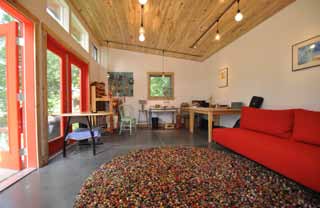 The demand for housing in the metro Bay Area is far outpacing the supply, a phenomenon that is driving inflated real estate prices even higher. There are high-rise apartment buildings popping up all over San Francisco to meet the housing needs of the upwardly mobile and affluent. The trend that is gaining momentum in the East Bay is the construction of cottages, studios and accessory buildings in the backyards of single family homes to help meet the housing needs of those that have been priced out of the market elsewhere.
The demand for housing in the metro Bay Area is far outpacing the supply, a phenomenon that is driving inflated real estate prices even higher. There are high-rise apartment buildings popping up all over San Francisco to meet the housing needs of the upwardly mobile and affluent. The trend that is gaining momentum in the East Bay is the construction of cottages, studios and accessory buildings in the backyards of single family homes to help meet the housing needs of those that have been priced out of the market elsewhere.
Housing demand in the East Bay is enormous, especially in walk-able neighborhoods with convenient commercial districts and public transportation where residents can reduce their reliance on cars. The premise that these desirable, well-established, single-family home neighborhoods should continue to be zero-growth zones is being challenged. Many city planners agree that small backyard accessory buildings represent part of the solution for promoting “Smart Growth” by providing more affordable housing for the swelling population without resorting to unsustainable suburban sprawl.
Berkeley has taken a proactive stance in leading this housing trend. “We favor increasing the nu mber of secondary units,” says Debra Sanderson, Planning Manager at the City of Berkeley. Regardless of the architectural form (backyard cottage, converted garage or pre-fabricated studio), legal Accessory Dwelling Units aka ADUs are part of the same property as the main home and cannot be bought or sold separately, as a condominium or a mobile home might be. These types of buildings appeal to homeowners looking for more space without relocating or going through the disruption of a major remodeling in their primary residence.
mber of secondary units,” says Debra Sanderson, Planning Manager at the City of Berkeley. Regardless of the architectural form (backyard cottage, converted garage or pre-fabricated studio), legal Accessory Dwelling Units aka ADUs are part of the same property as the main home and cannot be bought or sold separately, as a condominium or a mobile home might be. These types of buildings appeal to homeowners looking for more space without relocating or going through the disruption of a major remodeling in their primary residence.
On the smaller end of the ADU spectrum are the single-room studios that supplement the living space of the primary residence  versus functioning as independent dwellings. The most cost-effective ways to add one of these units to your backyard is to remodel a detached garage or purchase and construct a refabricated studio from brands such as Studio Shed (http://www.studio-shed.com/), Summerwood (http://www.summerwood.com/) and Modern Shed (http://modern-shed.com/). These structures are usually between 120 and 200 square feet of conditioned space and include electricity, insulation, drywall, flooring and sometimes plumbing. Prices range from $20,000-$50,000 depending on the size and the amenities that are included. Completing one of these projects is at least a 4–6 month process when you factor in planning, permits, fabrication, construction and city inspections.
versus functioning as independent dwellings. The most cost-effective ways to add one of these units to your backyard is to remodel a detached garage or purchase and construct a refabricated studio from brands such as Studio Shed (http://www.studio-shed.com/), Summerwood (http://www.summerwood.com/) and Modern Shed (http://modern-shed.com/). These structures are usually between 120 and 200 square feet of conditioned space and include electricity, insulation, drywall, flooring and sometimes plumbing. Prices range from $20,000-$50,000 depending on the size and the amenities that are included. Completing one of these projects is at least a 4–6 month process when you factor in planning, permits, fabrication, construction and city inspections.
 On the larger and more costly end of the spectrum are backyard cottages that function as permanent, self-contained dwellings. These take about six months to build after permitting (which can take up to a year depending on the city) and cost between $80,000 to $250,000. These cottages serve as good starter homes for children who return to the area after college. They can also function as first homes for newlyweds, safe and secure housing for aging parents, retirement homes and, in some cases, rental property.
On the larger and more costly end of the spectrum are backyard cottages that function as permanent, self-contained dwellings. These take about six months to build after permitting (which can take up to a year depending on the city) and cost between $80,000 to $250,000. These cottages serve as good starter homes for children who return to the area after college. They can also function as first homes for newlyweds, safe and secure housing for aging parents, retirement homes and, in some cases, rental property.
Accessory Dwelling Units are a smart way for communities to meet the housing needs of the growing population. ADU’s are also a smart way for families to meet their own changing needs and significantly increase the value of their homes in the process.
Jim Tibbs is the creative director of HDR Remodeling. If you would like to learn more, please read his blog at http://hdrremodeling.wordpress.com or follow him on Twitter @HDRremodeling1.
Recent Comments